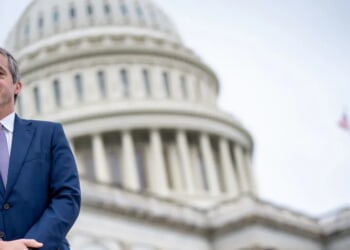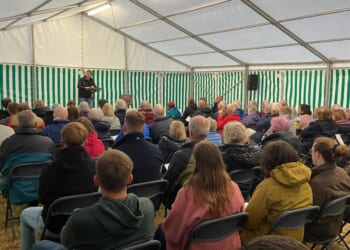While the Big Beautiful budget bill recently enacted into law has a multiplicity of good, bad, and benign features, the law’s biggest and most beautiful feature is the continuation of the soon-to-expire 2017 income tax reduction enacted in Donald Trump’s first term. Although much of the American press has characterized this as a big gift to the rich, the empirical evidence paints an altogether different picture.
By 2019, the second year of the Trump tax cut and immediately before the economic disruption of the pandemic, total output rose by 3.2 percent annually, the greatest growth in 15 years. And it was the poor, not the rich, who disproportionately benefited. (RELATED: Take the Win on the Big Beautiful Bill)
The poverty rate in the last Obama year, 2016, was 12.7 percent, but it fell to 10.5 percent, the lowest level ever recorded, by 2019. Similarly, the black unemployment rate fell from 7.5 percent when Trump first took office to 5.5 percent in November 2019, also the lowest level ever recorded. But our federal system of government provides even more striking evidence of the power of low taxes to improve lives.
For example, people flee high-tax states for lower tax ones in astonishing numbers. Using recently released Census Bureau data, we looked at the interstate migration of native-born Americans over the four years from mid-2020 to mid-2024. (RELATED: What Migration Patterns Within the U.S. Tell Us About Policy)
There were nine states that generally did not tax income during that period: Alaska, Florida, Nevada, New Hampshire, South Dakota, Tennessee, Texas, Washington, and Wyoming. Some 1,970,582 more people moved into those states than away from them in those four years. That’s roughly 1,350 a day or nearly one person every minute. (RELATED: Americans Are Fleeing Blue States in Droves)
Contrast that to California (which has a maximum state income tax rate of 13.3 percent) and similarly taxed New York. Over 2.4 million more Americans left those states than moved in. No wonder successful entrepreneurs like Tesla and SpaceX’s Elon Musk, Palantir’s Joe Lonsdale, and hedge fund manager Ken Griffin left heavy tax states like California or Illinois for Texas or Florida.
Some say Florida, Texas, and even Tennessee are relatively warm states that people prefer over colder destinations that also just happen to have high-income taxes like New York. It’s climate, not taxes, they argue. How, then, do you explain why there was net out-migration from balmy Hawaii and California, but in-migration to frosty New Hampshire, South Dakota, and Wyoming?
Moreover, states that were moving towards a no-income tax nirvana were similarly rewarded with new arrivals. For example, a decade ago, Arizona had an income tax with a 4.4 percent top rate, but in the last few years Republicans pushed through sharp reductions to 2.5 percent and gained over 252,000 new residents from 2020-2024 via migration. On the other hand, neighboring New Mexico, which maintained a 5.9 percent top rate, actually had net out-migration.
There are more examples. At the beginning of the last century, the population of New Hampshire was only modestly greater than neighboring Vermont, whereas today it is more than double. In the 1990s, there was a film, “Vermont is for Lovers.” Maybe tax lovers. Vermont has a stiff 8.75 percent income tax rate for taxpayers making $230,000 a year, while New Hampshire’s rate is zero.
Markets adjust to the migration reality. At this writing, it costs about 50 percent more to rent a large U-Haul truck to move a family from high-income tax New York City to no-income tax Austin, Texas, than to do the reverse move, from Austin to New York. That’s because few people want to move to New York while many want to move to Austin, so there is a truck shortage in New York and a surplus in Austin.
People strongly want lower taxes, and that overcomes adverse effects of some of the other provisions of the recently approved legislation. Congress, to be sure by the narrowest of margins — with Vice President Vance casting the tie-breaking vote — actually gave the public something that empirical evidence suggests they strongly wanted, demonstrating what Lincoln memorably called a government of the people, by the people, and for the people. High tax state governments should take a lesson.
READ MORE:
Please Pass the (Smarter, Free Market) SALT Deduction
Improving Both Federal Finances and Economic Growth
Let Colleges Fail: Use Creative Destruction
Richard Vedder is distinguished professor emeritus at Ohio University and a senior fellow at both Unleash Prosperity and the Independent Institute. Steve Moore is co-founder of Unleash Prosperity and a senior visiting fellow at The Heritage Foundation.


![Former Bravo Star Charged After Violent Assault Using a Rock-Filled Sock in Tennessee Walmart [WATCH]](https://www.right2024.com/wp-content/uploads/2025/07/Former-Bravo-Star-Charged-After-Violent-Assault-Using-a-Rock-Filled-350x250.jpg)



![Illegal Alien Walked Free After Decapitating Woman, Abusing Corpse for Weeks [WATCH]](https://www.right2024.com/wp-content/uploads/2025/07/1753013138_Illegal-Alien-Walked-Free-After-Decapitating-Woman-Abusing-Corpse-for-350x250.jpg)
![U.S. Marshals Lead the Largest Child Rescue Operation in Florida History, Possibly Even in the Country [WATCH]](https://www.right2024.com/wp-content/uploads/2025/06/US-Marshals-Lead-the-Largest-Child-Rescue-Operation-in-Florida-350x250.jpg)
![NYC Man Snatches Child Off The Sidewalk, Parents Chase Him Down [WATCH]](https://www.right2024.com/wp-content/uploads/2025/07/NYC-Man-Snatches-Child-Off-The-Sidewalk-Parents-Chase-Him-350x250.jpg)
![Man Arrested After Screaming at Senators During Big Beautiful Bill Debate [WATCH]](https://www.right2024.com/wp-content/uploads/2025/06/Man-Arrested-After-Screaming-at-Senators-During-Big-Beautiful-Bill-350x250.jpg)






